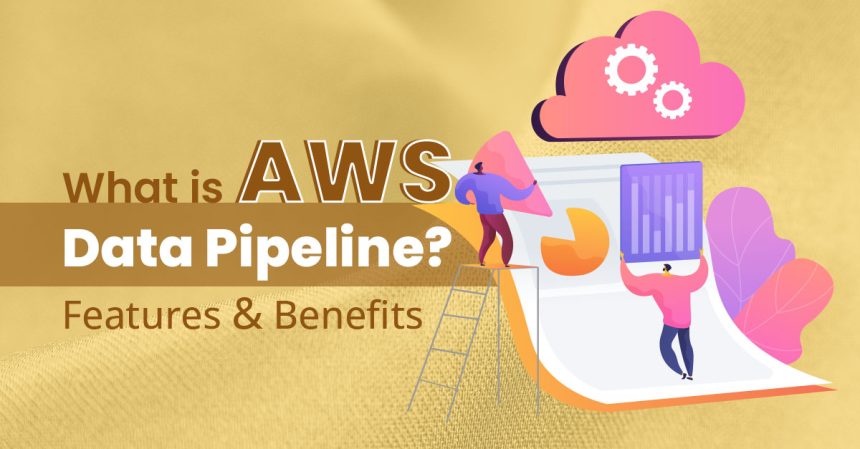AWS Data Pipeline is a web service provided by Amazon Web Services (AWS) that allows users to manage and process data. The service is designed to help users move and transform data between different data stores, such as Amazon S3, Amazon RDS, and Amazon DynamoDB, as well as external data sources, such as FTP servers and JDBC data sources.
If you are interested in learning more about AWS Data Pipeline and about its features and benefits, then you must check out Intellipaat’s AWS Solution Architect certification as it will guide you through all the core fundamentals of this specific topic.
Here are the following components of AWS Data Pipeline to discuss about and here are the following topics which are followed by:
- Features of AWS Data Pipeline
- Advantages and Benefits of using AWS Data Pipeline
- Uses of AWS Data Pipeline
- AWS Data Pipeline services
- Conclusion
Features of AWS Data Pipeline
One of the key features of AWS Data Pipeline is its ability to handle complex data processing tasks. The service allows users to create data pipelines that can perform a wide range of tasks, such as data extraction, data transformation, and data loading. Additionally, AWS Data Pipeline provides built-in activities, such as data movement and data validation, that can be used to streamline the data pipeline process.
Another key feature of AWS Data Pipeline is its ability to schedule and run data pipelines on a recurring basis. This means that data pipelines can be set up to run automatically at specific times, such as daily or weekly, to ensure that data is always up-to-date. Additionally, AWS Data Pipeline allows users to easily monitor and troubleshoot data pipelines, which can help ensure that data is being processed correctly.
Advantages of Benefits of using AWS Data Pipeline
One of the main benefits of using AWS Data Pipeline is its scalability. As data pipelines can be easily set up to run on a recurring basis, users can easily scale their data processing capabilities to handle large amounts of data. Additionally, since the service is provided by AWS, users can take advantage of the scalability and reliability of the AWS infrastructure, which can help ensure that data pipelines are always running smoothly.
Another benefit of AWS Data Pipeline is its cost-effectiveness. The service is pay-per-use, which means that users only pay for the resources that they use, such as data storage and data processing. This can help users keep their data processing costs under control, especially as their data processing needs grow.
Uses of AWS Data Pipeline
AWS Data Pipeline can be useful for many use cases and an AWS Solution Architect certification or AWS course will be a great way to understand how to use this service. For example, it can be used for data warehousing and data integration tasks, such as moving and transforming data between different data stores. Additionally, it can be used for data analytics tasks, such as running data pipelines that extract, transform, and load data for use in business intelligence or machine learning applications.
One of the most powerful capabilities of AWS Data Pipeline is its ability to move and transform data between different data stores. The service supports a wide range of data sources, including Amazon S3, Amazon RDS, Amazon DynamoDB, and external data sources such as FTP servers and JDBC data sources. This means that users can easily move data from one data store to another, and can also perform a wide range of data transformations on the data as it is moved.
AWS Data Pipeline Services
AWS Data Pipeline also provides a wide range of pre-built activities that can be used to streamline data pipeline development. These activities include data movement, data validation, and data transformation, as well as more advanced activities such as data cleansing and data validation. Additionally, the service provides a visual tool called the Pipeline Designer, which makes it easy to create and manage data pipelines, even for users who are not experts in programming.
AWS Data Pipeline provides a range of options for scheduling and running data pipelines. Users can schedule data pipelines to run on a specific schedule, such as every day or every week, or to run in response to specific events, such as when new data is added to an S3 bucket. Additionally, the service provides a number of options for monitoring and troubleshooting data pipelines, which can help users ensure that data is being processed correctly.
AWS Data Pipeline is also built on top of the highly available and highly scalable AWS infrastructure. This means that data pipelines can be easily scaled to handle large amounts of data, and can run reliably even during periods of high traffic or data volume. Additionally, the service is fully managed, which means that users don’t have to worry about provisioning or managing the underlying infrastructure.
For your convenience, you can also refer to Intellipaat’s AWS Course YouTube video on AWS Data Pipeline that will help you to have a better insight into this particular topic. Both beginners and experts were considered when creating this video training.
Conclusion
In conclusion, AWS Data Pipeline is a powerful data processing service that can help users manage and process data effectively. With its ability to handle complex data processing tasks, its ability to schedule and run data pipelines on a recurring basis, and its scalability and cost-effectiveness, AWS Data Pipeline is an ideal solution for a wide range of data processing needs. To be proficient in using it, taking an AWS Solution Architect certification or AWS course would be a good idea.
As mentioned before, AWS Data Pipeline is a cost-effective solution. Users only pay for the resources they use, such as data storage and data processing, and can easily track their costs using the AWS Cost Explorer. Additionally, the service provides a number of options for controlling costs, such as the ability to set limits on the number of running tasks or on the amount of data processed.















